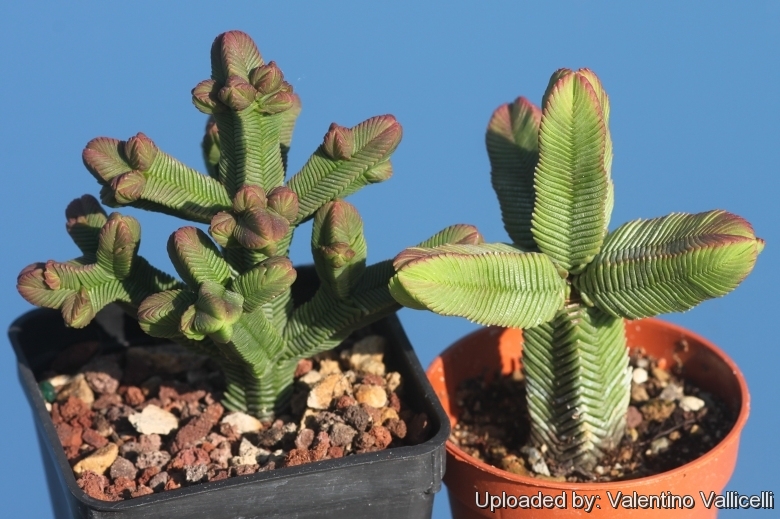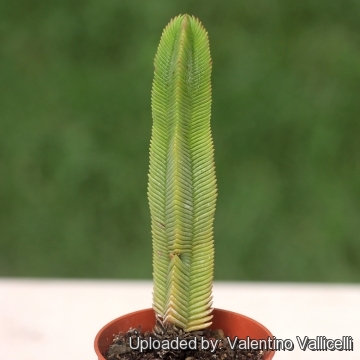Accepted Scientific Name: Crassula pyramidalis Thunb.
Nova Acta Phys.-Med. Acad. Caes. Leop.-Carol. Nat. Cur. : 329, 335. 1778

Crassula pyramidalis f. media Photo by: Valentino Vallicelli
Standard Crassula pyramidalis on the left and the larger forma "media" on the rigth.
Origin and Habitat: Garden origin (Nursery produced cultivar)
Synonyms:
See all synonyms of Crassula pyramidalis
back
Accepted name in llifle Database:Crassula pyramidalis Thunb.Nova Acta Phys.-Med. Acad. Caes. Leop.-Carol. Nat. Cur. : 329, 335. 1778Synonymy: 12
back
Description: Crassula pyramidalisSN|15551]]SN|12360]] f. media is a large form found only in cultivation with robust finger like quadrangular stems. It is somewhat intermediate in size between the standard thin stemmed Crassula pyramidalisSN|12360]]SN|12360]] and the larger stemmed "Crassula cv. Buddha&SN|12360]]SN|15551]]", it is not to exclude that this plant is an hybrid.
Habit: It is a small sparingly clustering succulent or small shrub, up to 25 cm tall, 20-50 cm in diameter with numerous closely imbricated leaves forming branched quadrangular columns.
Stem: Erect to decumbent, dichotomously branching which topples over with age, thin completely obscured by the tightly pressed leaves.
Roots: Fibrous.
Leaves: 10-20 mm across, ascending, equal-sized, extremely thin, flat, triangular-ovate, bright green to brownish-green that are firm and closely stacked on top of each other forming a perfect minaret-shaped quadrangular column about 25 mm in diameter, tappering at the obtuse tip. Margins entire, tip bluntly acute. In full sun sun the apical leaves can take a nice purple tinge.
Flowers: Small sweet-scented white to cream-pink appearing in a dens terminal cluster (cymose capitula) the basal part partly hidden by the leaves. Bud reddish.
Blooming season: Mid spring to summer, unfortunately plants die after blooming.
Subspecies, varieties, forms and cultivars of plants belonging to the Crassula pyramidalis group
 Crassula pyramidalis Thunb.: Tiny succulent shrub, up to 25 cm tall with numerous closely imbricated leaves forming a quadrangular colum. Flowers white. Distibution: Little Karoo, Namaqualand, Southern Africa
Crassula pyramidalis Thunb.: Tiny succulent shrub, up to 25 cm tall with numerous closely imbricated leaves forming a quadrangular colum. Flowers white. Distibution: Little Karoo, Namaqualand, Southern Africa Crassula pyramidalis f. media hort.: this is a larger form of Crassula pyramidalis. Distribution: known only in cultivation (hybrid?)
Crassula pyramidalis f. media hort.: this is a larger form of Crassula pyramidalis. Distribution: known only in cultivation (hybrid?)
 Crassula pyramidalis f. media Photo by: Valentino Vallicelli
Crassula pyramidalis f. media Photo by: Valentino Vallicelli Crassula pyramidalis f. media Photo by: Valentino Vallicelli
Crassula pyramidalis f. media Photo by: Valentino VallicelliCultivation and Propagation: Crassula pyramidalisSN|12360]]SN|12360]] is easy to grow under a wide variety of climatic conditions provided it is planted in a well-drained situation given adequate water but not over-watered.
Growth rate: It is a pretty slow grower.
Soil: Plants grow well in a well-drained mineral soil.
Pots: It needs a relatively shallow pot to accommodate its fibrous roots and provide a very good drainage. It may stay in the same pot for many years.
Watering: It needs moderate water – not too wet nor too dry from autumn to spring with regular water in summer (careful watering required in winter), fairly drought tolerant elsewhere.
Fertilization: Light fertilizer seems to boost its growth whenever additional water is given. Feed it during the growing season with a fertilizer specifically formulated for cactus and succulents (high potash fertilizer with a dilute low nitrogen), including all micro nutrients and trace elements diluted to ½ the strength recommended on the label. It thrive in poor soils and needs a limited supplies of fertilizer to avoid the plant developing excess vegetation, which is easily attacked by fungal diseases.
Special need: Provide very good ventilation. Nearly all problems occur as a result of overwatering and poor ventilation, especially when weather conditions are dull and cool or very humid.
Exposure: It cannot take direct sun in summer but generally needs sun part of the day to bloom. In deep shade it gets pretty weak and leggy and eventually rots and dies.
Pest and diseases: Crassulas are sensitive to mealybugs. Protect against frost.
Maintenance: After growing for several years tend to become untidy, and should be cut very short or restarted from cuttings.
Hardiness: Outdoors in frost free areas, indoors all other zones
Propagation: Seeds/ Stem cuttings. Sow seeds in autumn. Plants root easily from cuttings, place cuttings in clean river sand, mist every three to four days, roots should appear within 2-3 weeks.












